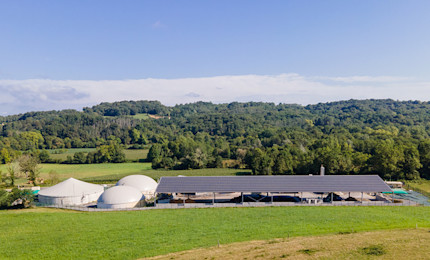Gas emergency 0 800 028 800

Teréga accelerates energy transition in response to the big challenges facing society
Teréga’s ambition is to support the transition of the French economy into carbon neutrality by 2050. Convinced of the essential place and role played by gas in achieving that energy transition, we involve ourselves in the development of innovative solutions which will lead to the emergence of the energy models of tomorrow.
Teréga accelerates the achievement of carbon neutrality
The road maps for France and the European Union achieving carbon neutrality in 2050 are ambitious. Article 1 of the Energy and Climate Law enacted in November 2019 makes that target official, suggesting that emissions of greenhouse gases need to be reduced by a factor of more than six between now and 2050, compared with four in the 2015 law on Energy Transition for Green Growth. That ambition is shared at the European level: the Green Deal announced by the European Commission has also set a target of carbon neutrality by 2050, reaffirming the role to be played by green gases in that decarbonisation.
Teréga fully supports the carbon neutrality targets set by France and Europe and is developing its whole strategy in that direction. The role played by gas grids, storage sites and methane terminals, for example, will be crucial in deploying hydrogen in France and achieving carbon neutrality in 2050 at a reasonable cost. In the medium term, our infrastructures must be ready to accept the new sustainable gases, from pure hydrogen to biomethane.
Far from limiting itself to natural gas, the Teréga grid presents tremendous opportunities to create the energy mix of tomorrow and the integration of the energy sectors.
Gas: at the heart of new energy systems and challenges
As an accelerator of energy transition, Teréga is committed to designing innovative solutions which will build the models of tomorrow and allow the optimisation of energy consumption. Starting today: industrial and digital technologies enabling work to design multi-energy Smart Grids, integrated energy systems within which different sources of energy will be connected with one another and linked to each other.
Within the context of energy transition supported by digital transformation, innovation is a strategic issue for us. Our innovative process puts Teréga at the heart of the low-carbon, delocalised and diversified energy system of tomorrow, designing solutions which exploit the performance, flexibility and adaptability of our gas storage and transport infrastructures.
Thus the IMPULSE 2025 project, launched in 2019, illustrates our ambition to deploy a smart multi-energy system combining gas, electricity and heat to form a unique grid which will serve the needs of environmental and energy transition.
By 2025 we hope this project will enable us to recover lost energy, optimising appropriate usage for the consumer at the opportune time, and thus including a circular economy approach.

Dominique MocklyChairman and CEO of TerégaThe Impulse 2025 project will allow us to demonstrate that it is by optimising existing resources we will meet a large part of the challenges involved in environmental and energy transition.
Teréga: already an actor engaged in its own energy transition for some years
Through the BE POSITIF programme, we are committed to a responsible approach within our business activities, “avoiding, reducing, compensating for” our environmental footprint. Since 2012 we have been committed to a virtuous, exemplary approach to seeking carbon neutrality.
Our in situ experimentation with such a process, within our company and within our regions, means we can now legitimately tackle energy transition with all the necessary practical experience. Besides which, our IMPACTS 2025 strategy plan has been developed to meet our social objectives and expectations in terms of the integration of energy systems and carbon neutrality.
Where does digital come into all that?
We ensure we maintain our Information System with a high level of availability, to guarantee the continuity of our activities and achieve some of the best performance levels in the market. Alongside that, we continue our efforts to reduce our Information System’s costs and environmental impact. Digital frugality is written into the BE POSITIF programme, and our digital strategy is optimised to reduce our consumption of resources. Our digital carbon footprint is the subject of regular situation reports, and that enables us to monitor the effects of improvements we have already made and propose new action when necessary.









